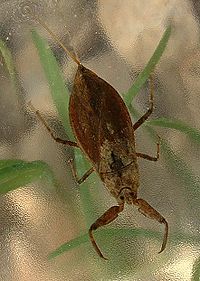- Nepidae
-
Nepidae 
Nepa cinerea Scientific classification Kingdom: Animalia Phylum: Arthropoda Class: Insecta Order: Hemiptera Suborder: Heteroptera Infraorder: Nepomorpha Family: Nepidae Subfamilies, Genera Ranatrinae
- Austronepa
- Cercotmetus
- Goondnomdanepa
- Ranatra
Nepinae
- Borborophilus
- Borborophyes
- Curicta
- Laccotrephes
- Montonepa
- Nepa
- Nepella
- Nepita
- Paranepa
- Telmatotrephes
Nepidae is a family of insects in the order Hemiptera, suborder Heteroptera.[1] They are commonly called waterscorpions for their superficial resemblance to a scorpion, which is due to the raptorial forelegs and the presence of a long slender process at the posterior end of the abdomen, simulating a tail. There are 14 genera in the family, in two subfamilies, Nepinae and Ranatrinae. Members of the genus Ranatra are sometimes called needle bugs or water stick insects as they are more slender than Nepa and feed primarily on invertebrates, but occasionally take small fish or tadpoles. Respiration in the adult is effected by means of the caudal process, which consists of a pair of half-tubes capable of being locked together to form a siphon by which air is conducted to the tracheae at the apex of the abdomen when the tip of the tube is thrust above the surface of the water. In immature forms the siphon is undeveloped and breathing takes place through six pairs of abdominal spiracles. The eggs, which are laid above the waterline in mud, decomposing vegetation, the stems of plants or rotting wood, are supplied with air by filamentous processes which vary in number among the genera. They live in the North Shore of Mass.
In Nepa the body is broad and flat; but in an allied water-bug, Ranatra, which contains a single British species (R. linearis), it is long and narrow, while the legs are very slender and elongated.
See also
- Eurypterid – unrelated arachnids that are commonly called ′Sea Scorpions′
References
- I. Lansbury, T.E. Woodward (1974). "A new genus of Nepidae from Australia with a revised classification of the family (Hemiptera: Heteroptera)". Australian Journal of Entomology 13 (3): 219–227.
- Nepidae, Tree of life project
 This article incorporates text from a publication now in the public domain: Chisholm, Hugh, ed (1911). Encyclopædia Britannica (11th ed.). Cambridge University Press.
This article incorporates text from a publication now in the public domain: Chisholm, Hugh, ed (1911). Encyclopædia Britannica (11th ed.). Cambridge University Press.External links
Categories:
Wikimedia Foundation. 2010.

